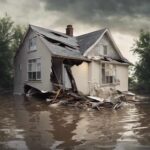
Water damage can be a homeowner’s worst nightmare. Whether it’s caused by a burst pipe, a leaky roof, or a natural disaster, the aftermath of water damage can be daunting. However, if you act quickly and follow the right steps, you can effectively handle water damage and minimize its impact on your property.
In this comprehensive guide, we will walk you through the entire process of handling water damage, from prevention to restoration. Detailed step-by-step process to help you minimize further damage and handle water damage properly. Here is a step-by-step guide on How to Handle Water Damage:
Prevention is Key
The best way to handle water damage is to prevent it from occurring in the first place. Regular maintenance and a proactive approach can go a long way in safeguarding your home. Here are some preventive measures you should take:
1. Inspect your property regularly: Regularly inspect your home for potential problem areas. Look for signs of leaks, such as water stains, mold growth, or dampness, and address them promptly.
2. Maintain your plumbing system: Keep an eye on your plumbing system. Check for leaks, drips, or damaged pipes. Replace worn-out hoses, connectors, or gaskets to prevent potential water damage.
3. Clean your gutters and downspouts: Clogged gutters and downspouts can lead to water overflow, which can damage the foundation of your home. Clean them regularly and ensure proper drainage.
4. Install a sump pump: If your home is prone to flooding, consider installing a sump pump in your basement or crawl space. It can help remove excess water and prevent damage.
5. Keep trees and shrubs trimmed: Overgrown trees and shrubs can cause damage to your roof or siding during storms. Keep them well-trimmed to prevent water damage from falling branches or rubbing against your home.
Dealing with Water Damage
Despite taking preventive measures, water damage can still occur unexpectedly. If you find yourself facing water damage, here is a step-by-step guide on how to handle it effectively:
1. Ensure safety: Before entering the affected area, make sure it is safe to do so. Turn off the electricity and gas supply to prevent any potential hazards. Wear protective gear such as gloves, rubber boots, and a face mask to protect yourself from contaminants.
2. Document the damage: Take photographs or videos of the affected area to document the extent of the damage. This will be useful for insurance purposes and to track the progress of your restoration efforts.
3. Stop the source of water: If the water damage is caused by a burst pipe or a leaking appliance, turn off the water supply to prevent further flooding. If the source cannot be immediately stopped, contact a professional plumber for assistance.
4. Remove standing water: Start by removing any standing water from your property. Use buckets, mops, or a wet/dry vacuum cleaner to extract the water. Be cautious while using electrical appliances or cords near water to avoid electrocution.
5. Dry out the area: After removing the standing water, focus on drying out the affected area completely. Open windows, use fans, and dehumidifiers to facilitate airflow and speed up the drying process. Remove wet furniture, carpets, and other belongings to prevent further damage and promote faster drying.
6. Assess the damage: Once the area is dry, assess the extent of the damage. Look for signs of structural damage, mold growth, or other issues that may require professional help. If you’re unsure, it’s always best to consult a water damage restoration specialist.
7. Clean and disinfect: Clean all surfaces with a mild detergent and warm water to remove any dirt or contaminants. Apply a disinfectant to kill bacteria or mold that may have developed due to the water damage. Ensure proper ventilation during the cleaning process.
8. Salvage or discard damaged belongings: Determine which belongings can be salvaged and which ones need to be discarded. Carpets, mattresses, and upholstered furniture may need to be replaced if they have been heavily saturated or show signs of mold growth.
9. Seek professional assistance: Depending on the extent of the damage, you may need to seek professional help for restoration and repairs. Contact reputable water damage restoration companies who have the expertise and equipment to handle the job efficiently.
10. Prevent future damage: Once the restoration process is complete, take steps to prevent future water damage. Implement preventive measures, such as installing a water leak detection system, sealing any vulnerable areas, or reinforcing your property’s defenses against water intrusion.
Hiring a Water Damage Restoration Company
If the water damage is extensive or if you’re unsure about handling the restoration process yourself, it’s advisable to hire a professional water damage restoration company. Here are some factors to consider when hiring a restoration company:
1. Reputation and experience: Choose a company with a solid reputation and extensive experience in handling water damage restoration. Read reviews, check their credentials, and ask for references to ensure their reliability.
2. Certification and training: Ensure that the company and its technicians are certified by recognized industry bodies. This ensures that they have received the necessary training and adhere to industry standards.
3. Availability and response time: Water damage requires immediate attention. Look for a restoration company that offers 24/7 emergency services and guarantees a quick response time to minimize further damage.
4. Range of services: Check if the company offers a comprehensive range of services, including water extraction, drying, mold remediation, and structural repairs. This ensures that they can handle all aspects of the restoration process.
5. Insurance coverage: Verify if the restoration company is licensed and insured. This protects you from any liability in case of accidents or damage during the restoration process.
Conclusion
Water damage can be devastating, but by following the steps outlined in this comprehensive guide, you can effectively handle water damage and minimize its impact. Remember, prevention is key, so take proactive measures to safeguard your home. In the event of water damage, act quickly and prioritize safety. Remove standing water, dry out the affected area, and assess the damage. Clean and disinfect the space, salvage or discard damaged belongings, and consider seeking professional assistance for a thorough restoration.
When you take the right steps, you can restore your home and ensure it is protected from future water damage. Hope you enjoyed this Detailed Guide on How to Handle Water Damage.






